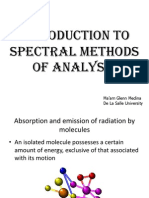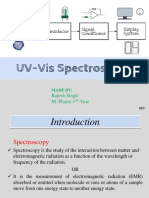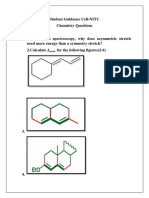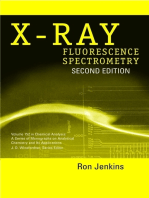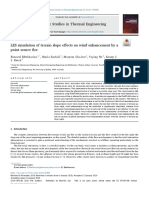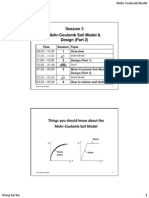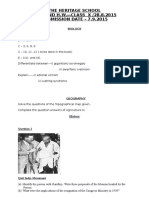Exercise Chapter 1
Uploaded by
ellina safianExercise Chapter 1
Uploaded by
ellina safianCOMPILATION PAST YEARS/TESTS QUESTIONS (2016 – 2018)
1 List any three (3) types of electromagnetic radiation in the order of decreasing frequency.
3 marks Feb 2018
2 Arrange the following electromagnetic radiation regions in order of increasing energy:
Microwave, X-ray, Ultraviolet, Visible
2marks Nov 2016
3 State two (2) properties of an electromagnetic radiation.
2 marks Mar 2017
4 Calculate the energy of an electromagnetic radiation with a wavelength of 322 nm.
2 marks Dec 2018
5 Calculate the frequency and energy for an electromagnetic radiation with a wavelength of
672 nm.
3 marks Nov 2016
6. A solution of 10 mg/L analyzed at 520 nm in a 1.0 cm cell using Spectrum 20 instrument
has 30% transmittance.
a) Calculate the absorbance if the concentration of the solution is diluted to 4.0 mg/L
under the same condition.
2 marks Oct 2016
b) Determine the percent transmittance of the diluted solution in (a)
2 marks Oct 2016
7 A laser pointer emits a narrow green light at 532 nm. Calculate the frequency of this green
light in Hertz (Hz)
2marks Jan 2018
8 Ultraviolet radiation has a frequency of 6.8 × 1015 s-1. Calculate the energy of the photon.
2marks Feb 2018
9 Ozone absorbs radiation of wavelengths 2200 – 2900 Å, thus protecting organisms from
this radiation. Find the frequency and energy of the most energetic of these photons.
Given h = 6.63 × 10-34 Js, c = 3.00 × 108 ms-1.
4 marks Test
10 A sample containing 5.78 ×10-4 mol/L of complex KMnO4 has a transmittance of 36.4%
in a 1.0 cm cuvette at 450 nm. Calculate the molar absorptivity of KMnO4 at this
wavelength. Given RAM for K=39.1 g/mol, Mn = 54.9 g/mol and O = 16 g/mol.
3 marks Nov 2016
11 Caffeine is one of the ingredients in a variety of soft and energy drinks. It has the molar
absorptivity of 1200 L mol-1 cm-1 at 270 nm (λmax). Given b = 1 cm. Calculate the
absorbance if a 3.4 × 10 -4 M caffeine solution is analyzed by UV-Visible spectroscopy.
2marks Mar 2017
12 A 20.5 mg sample of a dark-orange compound (molecular mass = 536.89 g/mol) was
dissolved with a solvent in a 100 mL volumetric flask. The absorbance of this solution at
451 nm was 0.856 in a 1.00 cm cuvette. Calculate the molar absorptivity of this compound.
3 marks Dec 2018
13 15 mg of paranitrophenol (C6H5NO3, MW = 139.11 g/mol) was dissolved with distilled
water in a 250 ml volumetric flask. The absorbance of this solution is 0.452 in a 1.00 cm
cuvette. Calculate the molar absorptivity of this compound.
3 marks Jan 2018
14 Chloroaniline (MW = 127 g/mol) in a sample is determined as the amine picrate, which
absorbs strongly at 360 nm (Ɛ = 1.24 × 104 cm-1 L mol-1). A 0.0375 g sample of
chloroaniline is reacted with picric acid and diluted to 1L. The solution exhibits an
absorbance of 0.469 in a 1.2 cm sample cell. Calculate the weight of chloroaniline in the
sample.
4 marks Test
15 Sketch and correctly label an ideal Beer’s Law plot
2 marks Test
16 Determine two (2) causes of deviation in Beer’s Law.
2marks Feb 2018
17 Differentiate between the cause of Beer’s Law real and instrumental deviation in UV-Vis
analysis.
5 marks Dec 2018
18 Deviations from Beer’s Law becomes noticeable at high concentration of samples. Briefly
explain the type of deviation.
3 marks Test
You might also like
- Circular Motion and Other Applications of Newton's LawsNo ratings yetCircular Motion and Other Applications of Newton's Laws65 pages
- Flexural Strengthing of Beam With FRP LamintaesNo ratings yetFlexural Strengthing of Beam With FRP Lamintaes6 pages
- Analysis II UV and IR Assignment Lideta StudNo ratings yetAnalysis II UV and IR Assignment Lideta Stud13 pages
- Introduction To Spectrochemical Methods 1No ratings yetIntroduction To Spectrochemical Methods 150 pages
- Basic Instrumental Analysis CHM260: An Introduction To Spectroscopic Methods of AnalysisNo ratings yetBasic Instrumental Analysis CHM260: An Introduction To Spectroscopic Methods of Analysis65 pages
- v= c λ m/s m Hz: = 3 x 10 550 x 10 = 5.46 x 10 1 = 1 550 x 10 = 1.8 x 10No ratings yetv= c λ m/s m Hz: = 3 x 10 550 x 10 = 5.46 x 10 1 = 1 550 x 10 = 1.8 x 102 pages
- 21 9 6 6. Chapter 13. Ultraviolet Visible Spectrophotometry 11.29No ratings yet21 9 6 6. Chapter 13. Ultraviolet Visible Spectrophotometry 11.2916 pages
- Student Guidance Cell-NITC Chemistry QuestionsNo ratings yetStudent Guidance Cell-NITC Chemistry Questions5 pages
- UV-Visible Spectroscopy and Application Module 1 PDF0% (1)UV-Visible Spectroscopy and Application Module 1 PDF138 pages
- Chapter 1-Introduction To Spectroscopy Method of AnalysisNo ratings yetChapter 1-Introduction To Spectroscopy Method of Analysis67 pages
- Lecture3 - CH317 - 2020 - Fall - Part1 - GG Class NowNo ratings yetLecture3 - CH317 - 2020 - Fall - Part1 - GG Class Now23 pages
- Ultraviolet/Visible Light Absorption Spectrophotometry (UV-Vis)No ratings yetUltraviolet/Visible Light Absorption Spectrophotometry (UV-Vis)63 pages
- Unit 5 Introduction To Spectrometry 2013-14No ratings yetUnit 5 Introduction To Spectrometry 2013-1416 pages
- Introduction To Spectroscopic Methods ofNo ratings yetIntroduction To Spectroscopic Methods of48 pages
- Experimental and Theorical Analysis of The Moment-Rotation Behavior of Stiffened Extended End-Plate ConnectionsNo ratings yetExperimental and Theorical Analysis of The Moment-Rotation Behavior of Stiffened Extended End-Plate Connections15 pages
- Tutorial 2 (Fluid Properties) - Fluid MechanicsNo ratings yetTutorial 2 (Fluid Properties) - Fluid Mechanics3 pages
- Fundamentals of Kinesology and Biometrics in SportsNo ratings yetFundamentals of Kinesology and Biometrics in Sports23 pages
- Case Studies in Thermal Engineering: Esmaeel Eftekharian, Maria Rashidi, Maryam Ghodrat, Yaping He, Kenny C. S. KwokNo ratings yetCase Studies in Thermal Engineering: Esmaeel Eftekharian, Maria Rashidi, Maryam Ghodrat, Yaping He, Kenny C. S. Kwok10 pages
- Wong Design Analysis Deep Excavations Session03No ratings yetWong Design Analysis Deep Excavations Session0355 pages
- Hamilton's Principle and Symmetries: Sourendu GuptaNo ratings yetHamilton's Principle and Symmetries: Sourendu Gupta14 pages
- PHYSICS - Model Paper - I Section - A: I - Answer All The QuestionsNo ratings yetPHYSICS - Model Paper - I Section - A: I - Answer All The Questions6 pages
- Design of Cold-Formed Steel Built-Up Post Members - TSNNo ratings yetDesign of Cold-Formed Steel Built-Up Post Members - TSN12 pages
- PHYSICS NOTES FOR Forest Guard - WWW - Governmentexams.co - in PDFNo ratings yetPHYSICS NOTES FOR Forest Guard - WWW - Governmentexams.co - in PDF150 pages
- Mohr - A Mohr Circle Construction For The Opening of A Pre-Existing FractureNo ratings yetMohr - A Mohr Circle Construction For The Opening of A Pre-Existing Fracture6 pages
- Quantum Physics For Beginners - Steven N. FulmerNo ratings yetQuantum Physics For Beginners - Steven N. Fulmer123 pages
- The Heritage School WEEKEND H.W.-CLASS X /28.8.2015 SUBMISSION DATE - 7.9.2015No ratings yetThe Heritage School WEEKEND H.W.-CLASS X /28.8.2015 SUBMISSION DATE - 7.9.20153 pages
- Design and Construction of A Deep Excavation in Soft Soils Adjacent To The Shanghai Metro TunnelsNo ratings yetDesign and Construction of A Deep Excavation in Soft Soils Adjacent To The Shanghai Metro Tunnels16 pages
- The KAM Story a Friendly Introduction to the Content, History, And Significance of Classical Kolmogorov-Arnold-Moser Theory (H.S. Dumas) (Z-lib.org)No ratings yetThe KAM Story a Friendly Introduction to the Content, History, And Significance of Classical Kolmogorov-Arnold-Moser Theory (H.S. Dumas) (Z-lib.org)298 pages
- The Moment-Gradient Factor in Lateral-Torsional Buckling On Inelastic Castellated BeamsNo ratings yetThe Moment-Gradient Factor in Lateral-Torsional Buckling On Inelastic Castellated Beams14 pages








